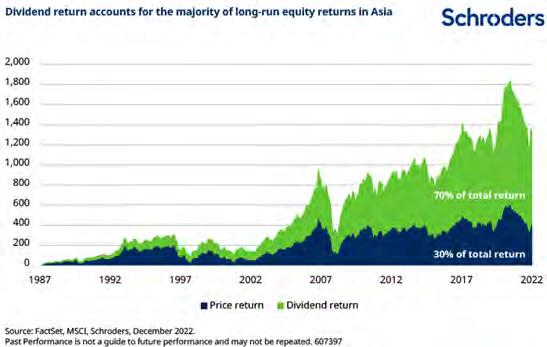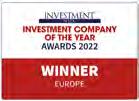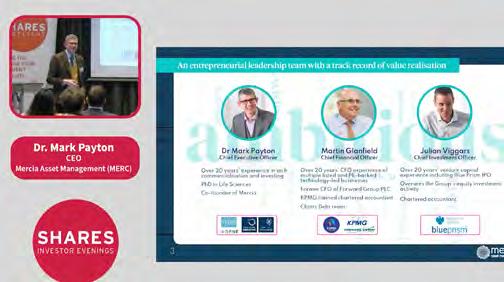BUILDING YOUR FIRST ISA

How

VOL 25 / ISSUE 08 / 02 MARCH 2023 / £4.49
Analyse them in just five minutes COMPANY RESULTS
with investing
to get started

Your call may be recorded for training or monitoring purposes. Issued and approved by Baillie Gifford & Co Limited, whose registered address is at Calton Square, 1 Greenside Row, Edinburgh, EH1 3AN, United Kingdom. Baillie Gifford & Co Limited is the authorised Alternative Investment Fund Manager and Company Secretary of the Trust. Baillie Gifford & Co Limited is authorised and regulated by the Financial Conduct Authority. The investment trusts managed by Baillie Gifford & Co Limited are listed UK companies and are not authorised or regulated by the Financial Conduct Authority. Actual Investors SCOTTISH AMERICAN INVESTMENT COMPANY We focus on delivering a long-term income. Because no one plans a short-term retirement. SAINTS invests globally in companies that not only pay healthy dividends today, but are also investing in their businesses, aiming to pay higher dividends in years to come. It aims to deliver a winning combination of income, growth and dependability, and is a solution that could be well suited to investors planning a long and happy retirement. Please remember that changing stock market conditions and currency exchange rates will affect the value of the investment in the fund and any income from it. Investors may not get back the amount invested. Find out more at saints-it.com A Key Information Document is available. Call 0800 917 2112.
• Find out why the Fed’s preferred inflation measure upset markets



• Latest letter from Buffett underlines importance of owning great businesses
• Autodesk stock tanks on margin and free cash flow guidance, wiping out 2023 gains
• Pets at Home has investors purring with 37% share price rally

• Why Telecom Plus shares are down 30% since the start of December

Contents 06 NEWS
13 GREAT IDEAS New:
Edge MSCI World Quality
General
Updates: BAE Systems 19 FEATURE Building your first ISA: How to get started with investing 25 PERSONAL FINANCE How tax changes will make ISAs even more valuable to investors 28 FEATURE The small cap market is shrinking fast as businesses fail 31 CASE STUDY A classic investment approach has helped Chris build a big pot 34 EDITOR’S VIEW How the trading down trend is continuing to gather pace 36 EDUCATION How to analyse a company’s results in just five minutes 40 DANNI HEWSON The big consumer goods firms are running out of road on price hikes 42 ASK TOM What are the rules around topping up national insurance contributions? 45 INDEX Shares, funds, ETFs and investment trusts in this issue 28 09 40 19 14 02 March 2023 | SHARES | 03
iShares
Factor ETF /
Mills
backSageofOmahasayshecontinuesto theUSeconomycomewhatmay
I nvestorsin (BRK.B:NYSE)BerkshireHathawaytheinvestmentcompany ledbyWarrenBuffettandCharlieMunger, willhaveenjoyedthelatestshareholder letteralmostasmuchastheyenjoyedthefirm’s outperformancelastyear. Intermsofmarketvaluepershare,Berkshire gained4%in2022againstan18.1%fallforthe S&P500indexwithreinvesteddividends. Therefore,overthelastthreeyears–whichwere dominatedfirstbytheglobalpandemicthenbythe invasionofUkraine–shareholdershaveseenthe valueoftheirinvestmentriseby38%againstjust under25%forthebenchmark. Asusual,Buffettismagnanimousinputting thisperformancedowntothequalityofthe businesses Berkshireownsratherthananyabilitytopickstocks. however,Asidefromthegainsinitsshareholdings, whatreallymattersareBerkshire’soperatingearningsandonthatbasisthefirm hadagoodyearin2022notchinguparecord $30.8billion. holdings,Theseweremostlygeneratedbyitsquoted whichincludeAmericanExpress (AXP:NYSE) Apple(AAPL:NASDAQ) Bankof America(BAC:NYSE) Chevron(CVX:NYSE) CocaCola(KO:NYSE) HPInc(HPQ:NYSE) Moody’s (MCO:NYSE) OccidentalPetroleum(OXY:NYSE) andParamountGlobal(PARA:NASDAQ)
holdingsAsBuffettobserves,whenthefirm’s‘controlled’ areaddedtothelist,Berkshireis‘more thanbroadlyalignedwiththecountry’seconomicfuture isthecaseatanyotherUScompany’. (and)Hequips:‘Ihavebeeninvestingfor80years Ihaveyettoseeatimewhenitmadesensetomakealong-termbetagainstAmerica.’ Inasectiontitled‘TheSecretSauce’,hegoeson toremindinvestorsofthepowerofcompounding anddividendsandbuybacksusingAmericanExpress BerkshireCoca-Colaasexamples.finishedbuyingbothstocksinthe mid-1990s,paying$1.3billionapiece,yetits ColaAmexstakeisnowworth$22billionanditsCocadisciplinestakeisworth$25billion,thankstothe shareholdingsofreinvestingdividendsandwatchingits growinsizeandvalue. ThereisaswipeattheBidenadministration’s dislikeofsharebuybacks,whichhesaysfailsto thosediscriminatebetweenthosewhichaddvalueand whichdestroyvalue. ‘Whenyouaretoldthatallrepurchasesare harmfultoshareholders tothecountry,or toparticularlybeneficialtoCEOs,youarelistening demagogueeitheraneconomicilliterateorasilver-tongued (charactersthatarenotmutually exclusive).’
the legendary investor is thinking and why he’s in no mood to write off the US
BUILDING YOUR ISAFIRST
Howtoget started investingwith

Mwayanypeoplebelievethatcashisasafe ofsaving,butwhenitcomesto thethelongterm,cashisnotking.Over pasttwodecadesaverageUK Sincesavingsrateshavebeengoingoneway–down. about2012,averageinterestoncashsavingshavebeenabout2%ayearorless. Thisdeclinecouldbemanagedduringtheyears oflowinflationbutemergingfromthepandemic livinghasturnedallthatonitshead.Withthecost-ofrisingsharplysince2021,cashstashedaway hasbeenlosingvaluehandoverfist.True,average savingsrateshavealsobeenrising,butthecalculus ofrough10%inflationversusthe5%to6%youcan isgetonyoursavingsmeanstheir‘real’buyingpower roughlyhalvingeachyear. Saversshouldconsiderunlockingthelong-term theirinvestorsinthemselvesbybeingproactivewith financesandembracingtheopportunities availableonstockmarkets.ThisiswhereaStocks

to build your first ISA and get started with investing

steerInvestorsdonotneedtoslogforhoursoverfinancialstatementstogetarough
ISA,andSharesISA,sometimescalledanInvestment returnscanhelp,givingyouthepotentialforbetter thatcouldhelpyoubeatinflation.ISAstandsforIndividualSavingsAccount. Youmightworryaboutthechallengesof investing,anditcanappeardauntingforthose startingout.Itcanseemverycomplexand downconfusing.Thevalueofanyinvestmentcango moneyaswellasup,soyoumightenduplosing ratherthansavingit.ResearchbyLegal& General(LGEN)showsthat18%ofnewinvestorsfearmakingthewronginvestmentdecisions. ‘Knowingwheretostartishard–especially inturbulenttimes,’saysLornaShah,managing directorofLegal&GeneralRetailRetirement.
02March2023 SHARES 19 StevenFrazerNewsEditor

onhowastockisdoingW hatcanyoudoinfiveminutes? popSpendapenny,haveasmoke, milk,roundtheshopsforapintof butwhataboutanalysingThinkacompany’sfinancialresults?Think,no? wantingWarrenagain.Buffetthasfamouslyinvitedanyone tosellhimacompanytomakeaproposalof–andsayshewillbeabletogiveanindication investmenthisinterestwithinfiveminutes.Tobeclear, decisionsshouldnotbemadetoo quickly.Investorsneedtoreallyunderstandthe relativeprosandconsofacompanybeforethey invest,itsstrengths,weaknesses,threats,and opportunities. announcementButzoominginonkeypartsofaresultsandcomingtoaroughconclusiononisaskillthatfinancialjournalistshaverelied retailforyears.Anditcanbeequallyvaluablefor experienceinvestors,especiallythosewithreasonable whoalreadyknowtheirwayaroundaP&L(profitandlossaccount,orincome andstatement),balancesheet,cashflowstatement, revealimportantly,thenotesattheend,whichoften anawfullotofdetailthatsimplystickingwiththeheadlinenumberswouldmiss. reminder,Forthoseinneedofacompanyaccounts thisfeatureinSharesfromFebruary 2021mightbeuseful.WHY
YOU
FREECASHFLOW= OPERATINGCASHFLOW– CAPITALEXPENDITURES
Visit our website for more articles
Did you know that we publish daily news stories on our website as bonus content? These articles do not appear in the magazine so make sure you keep abreast of market activities by visiting our website on a regular basis.


Over the past week we’ve written a variety of news stories online that do not appear in this magazine, including:
04 | SHARES | 02 March 2023
36 | SHARES 02March2023
outhasbeenspentoncapitalexpenditureandpaid debtasdividends,howmuchhasbeenallocatedto repayment,andhowmuchhasbeenraised fromtheissueofnewshares.Itwillalsoshow depreciationandamortisationcharges,andany share-basedpayments.Someinvestorspreferto excludegoodwillamortisationandshare-based paymentsfromprofits. LetAllthisinformationfleshesoutthestory. companyuslookatarealexample,holidays OntheBeach(OTB),whichreported8fullyearresultsto30September2022on December2022.


Analysing a company’s financial statements in just five minutes
Travis Perkins shares down 3% on lower profit guidance and cautious outlook

Contents 1 News 02March2023 SHARES 07
whyFinally,forthoselookingforanexplanationof thefirmboughtandsoldtheUS-listedsharesofsemiconductormakerTSMC(TSM:NYSE),Buffettdoesn’tgointospecificsbutsayscoyly‘episodically itbecomeseasytobuypiecesofwonderfulbusinessesatwonderfulprices’. Latest letter from Buffett underlinesimportanceof owninggreatbusinesses
Three important things in this week’s magazine 2 3
Education:Analysingcompanyresults
SHOULDN’T BEGIN AT THE START Surprisingly,wedonotrecommendstartingatthe youbeginning,butwiththecashflowstatement.Once understandarefamiliarwiththisstatement,itissimpleto and,importantly,itisthehardestofthethreeformanagementtomanipulate. cashThecashflowstatementhelpsyouworkoutfree flow.Thisisanimportantcalculation,because ittellsyouhowmuchofthecashgeneratedbythe companyisavailabletoshareholders. Thisstatementalsotellsyouhowmuchcash
inHowtoanalyseacompany’sresults justfiveminutes
Ocado shares slump 8% as it racks up more losses and customers pull back from big weekly shop
AO World sparks up 20% as investors applaud third upgrade in four months
Investors need to see evidence that Zoom can rediscover its growth mojo
Buffett’s latest letter to Berkshire Hathaway shareholders drops
What
How
It can be nerve-wracking to take the plunge in the markets but this article outlines the basics
Explaining how to sift through the spin and get to the important details in a set of results
WE’LL FOCUS ON THE DIVIDENDS, YOU ENJOY THE COMMUTE

The Merchants Trust PLC

The Merchants Trust aims to provide an above average level of income that rises over time. So whilst we focus on investing in large UK companies with the potential to pay attractive dividends, you can focus on travel, family, home, retirement – whatever really matters to you. Although past performance does not predict future returns, we’ve paid a rising dividend to our shareholders for 40 consecutive years, earning us the Association of Investment Companies’ coveted Dividend Hero status. Beyond a focus on dividends, Merchants offers longevity too. Founded in 1889, we are one of the oldest investment trusts in the UK equity income sector. To see the current Merchants dividend yield, register for regular updates and insights, or just to find out more about us, please visit us online.
www.merchantstrust.co.uk






INVESTING INVOLVES RISK. THE VALUE OF AN INVESTMENT AND THE INCOME FROM IT MAY FALL AS WELL AS RISE AND INVESTORS MAY NOT GET BACK THE FULL AMOUNT INVESTED.

A ranking, a rating or an award provides no indicator of future performance and is not constant over time. You should contact your financial adviser before making any investment decision. This is a marketing communication issued by Allianz Global Investors GmbH, an investment company with limited liability, incorporated in Germany, with its registered office at Bockenheimer Landstrasse 42-44, D-60323 Frankfurt/M, registered with the local court Frankfurt/M under HRB 9340, authorised by Bundesanstalt für Finanzdienstleistungsaufsicht (www.bafin.de). The summary of Investor Rights is available at https://regulatory.allianzgi.com/en/investors-rights. Allianz Global Investors GmbH has established a branch in the United Kingdom deemed authorised and regulated by the Financial Conduct Authority. Details of the Temporary Permissions Regime, which allows EEA-based firms to operate in the UK for a limited period while seeking full authorisation, are available on the Financial Conduct Authority’s website (www.fca.org.uk).

THIS IS A MARKETING COMMUNICATION. PLEASE REFER TO THE KEY INFORMATION DOCUMENT (KID) BEFORE MAKING ANY FINAL INVESTMENT DECISIONS.
Find out why the Fed’s preferred inflation measure upset markets

The US central bank has consistently said it has more to do to tame inflation and the data is likely to be volatile
The latest data (24 February) shows inflation surprisingly accelerated in January as measured by PCE (personal consumption expenditure) the US Federal Reserve’s favourite inflation gauge. This went against expectations for a continued fall and, once again, undermined hopes for a pivot away from rate hikes by the Fed.
PCE measures how much consumers are paying for goods and services with the annual rate increasing to 5.4% from 5.3% in December 2022.
The Fed prefers to focus on core PCE which strips out volatile components such as food and energy costs. The bank believes PCE is a broader and timelier measure than CPI (consumer price index).
The main reason is because CPI represents a fixed basket of consumer items which changes once a year. PCE is based on a basket of goods that consumers buy every month.
Annualised core PCE inched up to 4.7% from 4.6% while the monthly measure increased to 0.6% from 0.4%, the biggest jump since August 2022. Meanwhile consumer spending which accounts for more than two-thirds of GDP (gross domestic product) increased by 1.8%, the largest increase since March 2021.
The strong data capped off a disappointing week for both investors in shares and bond investors alike. Markets have started pricing in a higher chance of a 50 basis points interest rate rise.
According to CME’s (CME:NASDAQ) Fedwatch tool, at the end of January there were no expectations in the market for such a rise when the Fed next meets on 22 March.
Following the strong PCE reading, odds for a 50 basis point move have increased to a 25% while odds for a 25 basis point increase have dropped from 84% to 75%.
The latest evidence adds to a string of recent positive data the most surprising of which was January’s non-farm payrolls (3 February) which showed the US economy added 517,000 jobs compared with market expectations of just 187,000.
The news stopped the new year rally in its tracks which had seen the S&P 500 notch-up doubledigit percentage gains and the technology focused Nasdaq gain 18%.
Meanwhile US 10-year Treasury yields have risen (prices move in opposite direction) from just under 3.4% before the jobs data to 3.9%.
The setback in the Fed’s fight against inflation will be disappointing given hopes it was finally dissipating. At the press conference following the last monetary policy meeting (31 January) Fed chair Jerome Powell mentioned disinflation several times when answering questions.
The next important data releases for the economy which will be keenly watched and come out ahead of the next policy meeting are the monthly non-farm payrolls jobs for February (10 March) and CPI on 14 March. [MG]
News 06 | SHARES | 02 March 2023
Core US
price index (%) month on month percentage change Jan 2022 AprJulOctJan 2023 0.00 0.20 0.40 0.60 Chart: Shares magazine • Source: Forex Factory
PCE
Latest letter from Buffett underlines importance of owning great businesses
Investors in Berkshire Hathaway (BRK.B:NYSE), the investment company led by Warren Buffett and Charlie Munger, will have enjoyed the latest shareholder letter almost as much as they enjoyed the firm’s outperformance last year.
In terms of market value per share, Berkshire gained 4% in 2022 against an 18.1% fall for the S&P 500 index with reinvested dividends.
Therefore, over the last three years – which were dominated first by the global pandemic then by the invasion of Ukraine – shareholders have seen the value of their investment rise by 38% against just under 25% for the benchmark.
As usual, Buffett is magnanimous in putting this performance down to the quality of the businesses Berkshire owns rather than any ability to pick stocks.
Aside from the gains in its shareholdings, however, what really matters are Berkshire’s operating earnings and on that basis the firm had a good year in 2022 notching up a record $30.8 billion.
These were mostly generated by its quoted holdings, which include American Express (AXP:NYSE), Apple (AAPL:NASDAQ), Bank of America (BAC:NYSE), Chevron (CVX:NYSE), CocaCola (KO:NYSE), HP Inc (HPQ:NYSE), Moody’s (MCO:NYSE), Occidental Petroleum (OXY:NYSE) and Paramount Global (PARA:NASDAQ).
As Buffett observes, when the firm’s ‘controlled’ holdings are added to the list, Berkshire is ‘more broadly aligned with the country’s economic future than is the case at any other US company’.
He quips: ‘I have been investing for 80 years (and) I have yet to see a time when it made sense to make a long-term bet against America.’
In a section titled ‘The Secret Sauce’, he goes on to remind investors of the power of compounding dividends and buybacks using American Express and Coca-Cola as examples.
Berkshire finished buying both stocks in the mid-1990s, paying $1.3 billion apiece, yet its Amex stake is now worth $22 billion and its CocaCola stake is worth $25 billion, thanks to the discipline of reinvesting dividends and watching its shareholdings grow in size and value.
There is a swipe at the Biden administration’s dislike of share buybacks, which he says fails to discriminate between those which add value and those which destroy value.
‘When you are told that all repurchases are harmful to shareholders or to the country, or particularly beneficial to CEOs, you are listening to either an economic illiterate or a silver-tongued demagogue (characters that are not mutually exclusive).’

Finally, for those looking for an explanation of why the firm bought and sold the US-listed shares of semiconductor maker TSMC (TSM:NYSE), Buffett doesn’t go into specifics but says coyly ‘episodically it becomes easy to buy pieces of wonderful businesses at wonderful prices’. [IC]

News 02 March 2023 | SHARES | 07
Sage of Omaha says he continues to back the US economy come what may
Autodesk stock tanks on margin and free cash flow guidance, wiping out 2023 gains
Cloud engineering software firm still backed to deliver double-digit revenue growth by analysts

Cloud engineering software company Autodesk (ADSK:NASDAQ) gave investors a nasty shock after steering for soggy margins and free cash flow this year.
The company specialises in computer-aided design for buildings and is a holding in several global funds.
The latest disappointing news came alongside fourth-quarter and full year results to 31 January 2023 that beat expectations and showed a 28% jump in billings.
However, these positives were not sufficient to make up for the disappointing guidance.
Shares in the $42.5 billion business lost 13% on 24 February, the day following the after-hours announcement, falling to $192.53 and wiping out virtually the entire gains chalked-up this year.
‘While the fourth-quarter results were solid and ahead of expectations, in our opinion, the full year 2024 guidance was somewhat underwhelming, particularly on the margins outlook,’ Berenberg analysts told clients in a note.
‘The company is guiding to no margin expansions in full year 2024, which is below expectations,’ observes Berenberg, explaining their 2% downgrade of earnings per share estimates. The investment bank is now forecasting EPS of $3.77 on a reported basis, or $7.28 after adjustments.
For the full year to 31 January 2024, Autodesk sees adjusted EPS in a range between $6.98 to $7.32, largely missing consensus of $7.31. Revenue is seen in the range of $5.35 billion to $5.455 billion, again below expectations for revenue of $5.46 billion. Full-year billings are expected in the range of $5.03 billion to $5.18 billion, below the average analyst estimate of $5.34 billion.
The company reported fourth quarter 2023 EPS of $1.86 on revenue of $1.32 billion, beating the consensus for earnings of $1.81 per share on sales of $1.31 billion. Billings rose 28% year-on-year to $2.12 billion, crushing the average analyst estimate of $1.93 billion. An 8.2% increase in subscription revenues helped the total sales increase by 8.8%.
Free cash flow is expected to fall almost 50% to $1.2 billion, although the drop off is linked to a shift from multi-year contracts where cash is collected up front from business customers to an annual billing cycle.
‘Net/net, given the slightly weakerthan-consensus guidance along with stock outperformance this year versus the Nasdaq, we are not surprised to see the shares modestly tradeoff,’ said Stifel analysts. ‘While we acknowledge macro-uncertainty, we believe Autodesk has a number of drivers to sustain double-digit topline growth and operating margin/free cash flow expansion in coming years,’ they said in a note.
Autodesk is due to host an analyst day on 22 March 2023, providing the next potential catalyst for the shares, whether positive or negative. The risk for the business is a pronounced and sustained downturn in the construction industry which could put a significant dampener on profitability beyond this year.
News 08 | SHARES | 02 March 2023
[SF] Autodesk ($) Apr 2022 JulOctJan 2023 180 200 220 Chart: Shares magazine • Source: Refinitiv
Pets at Home has investors purring
with 37% share price rally
The pet food, accessories and vet services specialist is enjoying share price and earnings momentum
Shares in Pets at Home (PETS) have scurried 37% higher yearto-date amid a wider retail sector rally off recent lows with household incomes holding up better than feared.

But the real catalyst for Pets at Home was the delivery of another earnings upgrade on 31 January, where the UK’s clear pet care leader raised full year profit guidance after reporting strong sales for the third quarter including Christmas, despite the cost-of-living pressures facing customers.
With robust trading momentum continuing in the fourth quarter, Pets at Home expects underlying pre-tax profit for the year to March 2023 will be towards the upper end of the £126 million to £136 million consensus range, exceeding
previous guidance of £131 million. While Pets at Home benefited from a big increase in the UK’s pet population during lockdown, unlike other pandemic fads, this involved a long-term commitment on the part of owners. Positive trading trends at Pets at Home also show new CEO Lyssa McGowan is doing a good job of filling the big shoes of predecessor Peter Pritchard, who led a successful turnaround of the business. [JC]
Why Telecom Plus shares are down
Utility services supplier Telecom Plus (TEP), which trades as Utility Warehouse, has seen its share price plunge nearly 30% since the start of December.
There have been unhelpful headlines for the industry around Centrica (CNA) owned British Gas

using bailiffs to fit pre-payment meters and an ill-advised expensespaid trip to the Maldives for Utility Warehouse partners was crass. However there is a another more complex reason for the share price weakness as Numis analyst John Karidis explains: ‘Ofgem sets the price cap quarterly and suppliers must now fully hedge the cost of customers’ projected energy use. Thus, a supplier will make a big loss if the spot price falls steeply versus that assumed in the price cap, and a
customer churns early in the quarter.
‘In this scenario only, which may happen whilst spot prices remain volatile, the ‘acquiring supplier’ must pay the ‘losing supplier’ a material MSC (Market Stabilisation Charge).’
Numis estimates the MSC per typical household recruited averaged pretty much zero in 2022 but hit £424 in January. It now thinks Telecom Plus will hit rather than beat guidance for around 20% customer and pre-tax profit growth in the March 2023 financial year. [SF]
News 02 March 2023 | SHARES | 09
Telecom Plus (p) Sep 2022 Oct Nov DecJan 2023 Feb Mar 1,800 2,000 2,200 2,400 Chart: Shares magazine • Source: Refinitiv
30% since the start of December
Ofgem forces suppliers to account for cost of customers entire projected energy use DOWN in the dumps HIGHER Moving Pets at Home (p) Sep 2022 Oct Nov DecJan 2023 Feb Mar 300 350 Chart: Shares magazine • Source: Refinitiv
UK UPDATES OVER THE NEXT 7 DAYS
FULL-YEAR RESULTS
3 March: Rightmove, IMI, Vesuvius, Pearson, Faron Pharmaceuticals
6 March: BATM, Clarkson
7 March: Fresnillo, Foxtons, Greggs, Johnson Service, H&T, STV, Elementis, Reach, IWG, Just Group, Keller
8 March: Admiral, Legal & General, Ibstock, Quilter, Bakkavor, Spirent, Breedon, Headlam, Tullow Oil, TT Electronics, CLS, TClarke, Hill & Smith, Hiscox, Somero
9 March: Aviva, Pagegroup, Network International, Robert Walters, Entain, Harbour Energy, Forterra, Spirax-Sarco, M&G, Oakley Capital Investments, Franchise Brands, Informa, Convatec
HALF-YEAR
RESULTS
6 March: Craneware, Seeing Machines
7 March: Revolution Bars, DotDigital
8 March: Netcall, Darktrace, Galliford Try
9 March: Kier, Volution
QUARTERLY RESULTS
7 March: Ashtead
Investors are hoping the insurer doesn’t deliver the scale of bad news served up by Direct Line
Over the past year, a nasty profit warning by Direct Line (DLG), the cancellation of its dividend and suspension of a share buyback programme have put the shivers into anyone holding shares in the general insurance sector. The company was hit by a rise in claims and an increase in costs associated with fixing
Ashtead
There is a construction boom in the US which is good and bad news for tool hire firm
Theoretically, a boom in spending on infrastructure and clean energy developments in the US should be fantastic news for construction equipment rental group Ashtead (AHT).

The Associated Builders and Contractors industry group says there is a shortage of construction workers in the US, meaning delays to building work. Delays could benefit Ashtead if it just means that projects take longer to be completed as its equipment would be on loan for extra time. But a project’s start date
cars and homes.
Admiral (ADM) was understandably caught up in the sector worries and its shares have been in the doldrums for months. Suffice to say, expectations are low for its full year results, to be published on 8 March.
However, the Association of British Insurers says motor insurance pricing went up by 8% quarter on quarter in the last three months of 2022, providing some rays of hope for the sector. [DC]

might be delayed if there are not enough workers on day one, and that could mean companies wait before hiring equipment.
We might get an insight into this issue when Ashtead reports third quarter results on 7 March. In December, the company reported a ‘strong’ first-half performance and said full-year results would beat previous expectations. [DC]
News: Week Ahead 10 | SHARES | 02 March 2023
Brown-Forman
Jack Daniels maker has high hopes for ready-to-drink product that is mixed with Coca-Cola
Third quarter numbers from Jack Daniels producer Brown-Forman (BF.B:NYSE) are out on 8 March. The Louisville-based spirits maker reported organic sales and profit growth of 17% for the first six months of its financial year.
However, second quarter earnings were below expectations. The company was hit by the strong dollar which effectively increases the cost of its range of drinks to those outside the US, and rising costs.
This period benefited by comparison with one impacted by Covid restrictions. Guidance for organic growth in the high
Crowdstrike
Investors will have an eye on a recurring revenue metric when the cybersecurity firm reports
Strong results from sector peer Palo Alto Networks (PANW:NASDAQ) have helped lift the mood ahead of fourth quarter earnings from cybersecurity firm Crowdstrike (CRWD) on 7 March.

Crowdstrike is a leader in endpoint security – protecting desktops, laptops and mobile devices from digital threats.
In its third quarter the company said net new annual recurring revenue was below expectations thanks to macro-economic headwinds and saw its shares plunge. Investors are likely to be watching this metric closely again. [TS]
single digits suggests a second half slowdown.
Investors will be looking for an update on overseas sales of the ready-to-drink Jack Daniels & Coca-Cola product, from which the company was expecting big things ahead of its late 2022 launch in Mexico. It hits US shelves in March. [TS]

US UPDATES OVER THE NEXT 7 DAYS QUARTERLY RESULTS
3 March: Marvell
8 MARCH: Brown Forman, Campbell Soup
9 MARCH: Crowdstrike, Ulta Beauty
EUROPEAN UPDATES OVER THE NEXT 7 DAYS QUARTERLY RESULTS
7 March: Eurofins Scientific, Traton
8 March: Thales, Vivendi
News: Week Ahead 02 March 2023 | SHARES | 11
Capital at risk.
That’s the sweet sound of taking control of your investments with AJ Bell.



Buy this iShares ETF for its diversified exposure to shares without any dross
Filtering for high quality firms with stable earnings should eliminate the weakest companies
The conventional starting point for most investors is to identify which stocks they want to own and build a diversified portfolio around them.
While logical there may be a better way to go about the process which eliminates more risk. Why not start by identifying the weakest companies and eliminating them from a tailormade diversified index?
In other words, turn the conventional process on its head and start by deciding in advance which companies are not desirable. After all, research has shown that most companies underperform, so removing more of them will naturally increase the odds of better overall performance.
In the search for such products Shares discovered the iShares MSCI World Quality Factor ETF (IWFQ)
While the product, which reinvests any income from its holdings automatically, doesn’t fit the exact criteria it does come very close. In an increasingly uncertain world, the fund’s quality tilt should provide investors with a less bumpy ride while also providing steady capital growth.
The $2.4 billion fund seeks to reflect the return of the MSCI World Sector Neutral Quality index by applying three equally weighted quality factors.
The company characteristics include a high percentage of earnings allocated to shareholders, low levels of debt and low variability of year-onyear earnings.
HOW HAS THE FUND PERFORMED?
Over the last five years the fund has generated an annualised return of 10.1% a year. Thus easily beating the 6.7% annualised return of the global large cap equity blend index.
The largest geographical weighting is to the US at 69.9% while Europe including the UK represents 22% and the rest is spread across developed Asia.
ISHARES EDGE MSCI WORLD QUALITY FACTOR ETF (IWFQ)
Price: £40.30 Net assets: £1.95 billion
The fund is invested across 301 companies and given the sector neutral goal it is diversified across sectors with 40% allocated to interest rate sensitive sectors, just over a third in cyclicals and a quarter in defensive sectors.
The largest individual stock holding is US home improvement retailer Home Depot (HD:NYSE) which represents 4.4% of total assets.

Other top holdings include technology giants Microsoft (MSFT:NASDAQ), Apple (APPL:NASDAQ) and Nvidia (NVDA:NASDAQ).
Outside the US top holdings include Swiss consumer products company Nestle (NESN:SWX) and Danish diabetes and obesity drug specialist Novo Nordisk (NOVO:CPH)
The fund has an ongoing charge of 0.3% a year. Though remember, platform charges including dealing and custody fees need to be factored in on top. [MG]
iShares Edge MSCI World Quality Factor ETF
Great Ideas: Investments to make today 02 March 2023 | SHARES | 13
(p) 2016201820202022 1,000 2,000 3,000 4,000 Chart: Shares magazine • Source: Refinitiv
Cheerios maker General Mills has a tasty recipe for earnings upgrades

The cereals champion has scope for upside and offers a play on pet ownership
Investors seeking a resilient total return stock with forecast upgrade potential should open a position in General Mills (GIS:NYSE), the Minneapolis-based food multinational with positive momentum across its diversified business.
The $47.8 billion cap recently raised guidance (21 February) for the year to May 2023, citing resilient consumer demand and the growth opportunities across its brand portfolio.
Originally a major flour miller, today’s General Mills is a food giant with more than 100 brands sold globally, which reinvests its reliable cash flows behind its brands whilst returning cash to shareholders through dividends and buybacks.
The company makes and markets breakfast cereals Cheerios and Lucky Charms in a partnership with Nestle (NESN:SWX) as well as meals, snacks, ice creams and baking mixes. This includes household name brands including Nature Valley granola bars, Yoplait yoghurt and Haagen-Dazs ice cream as well as Old El Paso sauces, Gold Medal Flour and Wanchai Ferry wontons and dumplings.
Such a portfolio suggests General Mills is well placed to profit from the cost-of-living squeeze, which has led to increased at-home eating as cashstrapped consumers look to save money.
Guided by CEO Jeffrey Harmening, General Mills is cooking up profitable growth through its ‘Accelerate’ strategy with a focus on two businesses: North America Retail, its largest business in its largest core market and Pet Food, the fastest-growing part of General Mills, with much excitement surrounding the potential of the Blue Buffalo dog and cat food brand.
According to the company, Blue Buffalo is ‘well positioned for long-term continued growth as a leader in the humanisation of pet feeding and treating’. General Mills will soon test a new Fresh line of refrigerated Blue Buffalo dog food and is also investing in the expansion of Blue Buffalo Tastefuls, a new line of wet cat food crafted to entice even the pickiest of felines.
General Mills also plans to expand Blue
GENERAL MILLS (GIS:NYSE)
Price: $80.98
Market cap: $47.8 billion
Buffalo products in China and begin testing the brand in other international markets in its 2024 financial year.
While the shares aren’t cheap on a 12-month forecast rolling price-to-earnings ratio of 18.7 with a 2.8% dividend yield, General Mills has pedigree in offsetting inflation through cost savings and price increases and has the capacity to serve up upgrades.
The company recently raised full year 2023 organic sales growth guidance to around 10% and its adjusted earnings per share (EPS) growth estimate to between 7% to 8%. Management is confident the consistent execution of its Accelerate strategy leaves the firm ‘well-positioned to continue driving profitable growth and toptier returns for its shareholders in the years to come’. [JC]
General Mills
Great Ideas: Investments to make today 14 | SHARES | 02 March 2023
(p) 2005201020152020 0 20 40 60 80 Chart: Shares magazine • Source: Refinitiv
It is time to lock in profit in BAE Systems after a strong run
Defence firm’s improved prospects now look fully reflected in its share price

BAE Systems
(BA.) 914.2p
Gain to Date: 24.2%
We flagged defence firm BAE Systems (BA.) at 736p in March 2022. This was based on the expectation a less stable world would increase the focus on defence spending and help improve the sector’s long-term prospects.
WHAT HAS HAPPENED SINCE WE SAID TO BUY?
Our thesis has played out as expected and BAE is among the top performers on the FTSE 100 over the past 12 months. Several members of NATO have responded to the greater threat posed by Russia by boosting their planned military expenditure. The company’s results for 2022 revealed an order book of around £59 billion as it secured nearly £37.1 billion of new orders – a record.
Berenberg analyst George McWhirter comments: ‘BAE has a balanced portfolio, with 45% of sales derived from services and support, and 35% from major programmes, providing revenue visibility well beyond our forecast horizon. Exposure to US growth sectors and programmes is also well diversified.’
Shrugging off supply chain issues, it was able to achieve revenue growth of 8.9% and this translated into stronger-than-expected earnings and free cash flow, the latter some 50% better than consensus expectations according to Jefferies at £1.95 billion. However, after a strong year the outlook for 2023 which accompanied the results was less positive. Guidance for earnings growth of 5% to 7% is short of what had been pencilled in by analysts at 9% and free cash flow of £1.2 billion is well below the £1.7 billion forecast. This reflects the fact that due
to the timing of payments on contracts, a significant chunk of cash was pulled forward into 2022.
WHAT SHOULD INVESTORS DO NEXT?
After a very strong run for the share price, some of which came in the immediate aftermath of the Russian invasion and before we said to buy, the shares no longer look as attractive. According to Stockopedia data the stock trades on a 2023 price to earnings ratio of around 15.5 times and, as growth starts to slow, we see a risk of the shares losing their appeal with investors. Take profit. [TS]
Great Ideas Updates 02 March 2023 | SHARES | 15
BAE Systems (p) 2022 2023 400 500 600 700 800 900 Chart: Shares magazine • Source: Refinitiv
As growth starts to slow, we see a risk of the shares losing their appeal with investors”
The compelling case for dividend investing in Asia



It is no secret that stock markets are generally obsessed with share price appreciation. As tales of “multi-baggers” abound in Asia, many an investor has been seen chasing pipe dreams. Yet when one takes a step back and decomposes the region’s equity performances, in reality almost threequarters of Asia’s long-run equity returns have historically come from dividends.
this is where the similarities end.
Abhorring the notion of paying dividends, Korean corporates have largely kept their payout ratios unchanged over the last two decades even as their Singaporean counterparts consistently raised theirs. This has seen companies from the Lion City deliver a whopping 690% dividend return to their investors over 1988-2022, a figure that easily dwarfs the 345% from the Land of the Morning Calm.
For investors hoping to take a leaf out of the history books, focusing on dividends is clearly key.
Consider the experiences of Singapore and Korea. Both countries were known for their rapid economic growth rates in the 1990s which propelled their economies from agrarian societies in the 1960s into the industrialised nations that they are today. Both their stock markets have also delivered almost identical price returns over the last 35 years. And yet
HIGHER DIVIDENDS = HIGHER EARNINGS GROWTH
Doubters, however, balk at this notion. Why bother with boring dividends in a vibrant place like Asia,
ADVERTISING FEATURE
signalling effect”. As such, for investors seeking to benefit from the Asian economic growth story, focusing on high payout companies is definitely key.

HIGHER DIVIDENDS = BETTER CORPORATE GOVERNANCE
In a region riddled with corporate governance pitfalls, focusing on dividends has the added benefit of keeping investors away from potential disasters. This is because companies reduce the temptation
to waste money on value-destroying investments when they return excess cash to shareholders. They also subject themselves to more stringent levels of stakeholder scrutiny when they next tap the markets for funds.
Dividends can only be paid out of real earnings and real cash flows. As a result, Asian companies that pay high dividends are frequently also those with high corporate governance standards.
DIVIDEND STOCKS APPEAL TO OLDER INVESTORS
What is of note is that older clients are also increasingly demanding more dividends from their investments. This is perhaps not surprising.
Behavioural economists Hersh Shefrin and Richard Thaler have long theorised that individuals do not see all money equally. Instead they mentally break down their wealth into three separate, nonfungible baskets, namely current income, current assets and future income. For them, the propensity to spend out of current income is always the greatest while the temptation to do the same out of future income is the least. And because dividends are viewed as current income, people are happy to spend them. Capital gains, on the other hand, are largely viewed as future income and “jam tomorrow”. The tendency to spend out of them is therefore much lower.
For older customers facing retirement, this distinction is important because they will increasingly prefer to receive dividends from their stocks in order to fund their consumption. This should also see them rotating more into stocks paying high dividends. In a world that is rapidly ageing, the demand for dividends from the growing cohorts of retirees and soon-to-retire will underpin demand for dividend payers, making these stocks attractive investments on a longer-term basis.
Given how big a component of long-term equity returns dividends have historically been, and knowing how strong their demand from the ageing population will be, any investor who is looking for fast-growing companies with strong corporate governance in Asia will do well to pay heed to them.
Explore a range of investment solutions through our Asian investment trust range at Schroders.

Schroder Oriental Income Fund Limited
Schroder Japan Growth Fund plc
Schroder AsiaPacific Fund plc
Schroder Asian Total Return Investment Company
This is a marketing communication.
Past performance is not a guide to future performance and may not be repeated.
The value of investments and the income from them may go down as well as up and investors may not get back the amounts originally invested.
The material is not intended to provide, and should not be relied on for, accounting, legal or tax advice, or investment recommendations. Reliance should not be placed on any views or information in the material when taking individual investment and/or strategic decisions.
Any reference to sectors/countries/stocks/ securities are for illustrative purposes only and not a recommendation to buy or sell any financial instrument/securities or adopt any investment strategy.
Information herein is believed to be reliable but Schroders does not warrant its completeness or accuracy.
For help in understanding any terms used, please visit address www.schroders.com/en/insights/ invest-iq/investiq/education-hub/glossary/
We recommend you seek financial advice from an Independent Adviser before making an investment decision. If you don’t already have an Adviser, you can find one at www.unbiased.co.uk or www.vouchedfor.co.uk
Before investing in an Investment Trust, refer to the prospectus, the latest Key Information Document (KID) and Key Features Document (KFD) at www.schroders.co.uk/investor or on request.
Issued in February 2023 by Schroder Unit Trusts Limited, 1 London Wall Place, London EC2Y 5AU. Registration No 4191730 England.
Authorised and regulated by the Financial Conduct Authority
BUILDING YOUR FIRST ISA
How to get started with investing
Many people believe that cash is a safe way of saving, but when it comes to the long term, cash is not king. Over the past two decades average UK savings rates have been going one way – down. Since about 2012, average interest on cash savings have been about 2% a year or less.
This decline could be managed during the years of low inflation but emerging from the pandemic has turned all that on its head. With the cost-ofliving rising sharply since 2021, cash stashed away has been losing value hand over fist. True, average savings rates have also been rising, but the calculus of rough 10% inflation versus the 5% to 6% you can get on your savings means their ‘real’ buying power is roughly halving each year.
Savers should consider unlocking the long-term investors in themselves by being proactive with their finances and embracing the opportunities available on stock markets. This is where a Stocks
By Steven Frazer News Editor
and Shares ISA, sometimes called an Investment ISA, can help, giving you the potential for better returns that could help you beat inflation. ISA stands for Individual Savings Account.
You might worry about the challenges of investing, and it can appear daunting for those starting out. It can seem very complex and confusing. The value of any investment can go down as well as up, so you might end up losing money rather than saving it. Research by Legal & General (LGEN) shows that 18% of new investors fear making the wrong investment decisions.

‘Knowing where to start is hard – especially in turbulent times,’ says Lorna Shah, managing director of Legal & General Retail Retirement.

02 March 2023 | SHARES | 19
Long-range returns potential, value of £1,000

Note: Indicative example only, does not include any fees or charges Table: Shares magazine. • Source: Shares magazine
‘People will understandably be feeling unsure about the future at this moment in time.’
But she goes on to make a reassuring point: ‘The key thing to remember is that investing is for the long term. With time on your side, you can potentially balance out the ups and downs of the market.’

A century of data from the Barclays Equity Gilt Study shows that on average, stock markets have provided a total return to investors of about 6% a year, and that’s after factoring in the effects of inflation. Doesn’t sound much? Just look at the example in the table.
COVERING THE BASICS
Stocks and shares are units of ownership in a company. Companies sell them to shareholders to provide funding to grow their business. Some companies have millions of shareholders, who all own a tiny piece of the company; others have just a handful. People buy and sell shares on stock markets like the London Stock Exchange (LSE)
In practice, you should not expect a smooth journey. Stock markets move up and down all the time, so rather than getting 6% every year you’re more likely to see a more volatile pattern; 12% up one year, 5% down another year, 3% up, 7% down, 16% up, 9% down and so on.
HOW STOCKS AND SHARES CAN BEAT INFLATION
There are two ways for shareholders to ‘earn’ money:
• Selling their shares for a higher price than they paid for them (also known as a capital gain);
• Holding onto their shares in return for a payment from the company, known as a dividend.
20 | SHARES | 02 March 2023
5 £1,348.85 £1,221.00 £1,105.08 10 £1,819.40 £1,490.83 £1,221.20 15 £2,454.09 £1,820.30 £1,349.52 20 £3,310.20 £2,222.58 £1,491.33 25 £4,464.97 £2,713.77 £1,648.04 30 £6,022.58 £3,313.50 £1,821.21 Years 6% (long-range stock market returns average) 4% (splitting the difference) 2% (roughly the 10-year savings average)
That can create a return that’s higher than the rate of inflation, which is how the right investment can help you beat rising prices.
If there are concerns about the company’s growth or performance and demand for shares is low, the value of your shares will go down and you may get back less than you invested. There’s no guarantee on dividends either.
In a poor year, the directors may decide there isn’t enough surplus cash available from the business to pay shareholders what they were expecting, or any dividend at all. But it is important to remember, over the long term, dividends and share prices are likely to produce something close to their long-term averages.
There are three ways to invest in the stock market. You can:
• Choose the individual shares yourself;
• Employ an expert to choose the shares for you which can be prohibitively expensive if you are only investing relatively modest sums;
• Invest through an investment fund, where a fund manager chooses the shares on behalf of all the investors in the fund.
For example, investment platform AJ Bell (AJB) offers a selection of ready-made portfolios, hand-picked by its own investment experts, designed to suit anyone.
If you are a very careful person who wants to limit risks as much as possible, there’s a Cautious ready-made portfolio. Similarly, when you are younger and have a longer investment horizon, there’s an Adventurous option, or a Balanced portfolio which sits between the two. There’s also an Income ready-made portfolio, which typically suits those already in retirement.
There’s plenty to consider if you’re new to investing, such as:
• How high to set your budget;
• How long you’re likely to be investing;
• Your attitude to risk;
• How much you’re willing to lose if things don’t work out.
ASSESSING RISK
No single asset class can be relied on to always produce safe, reliable and consistent returns, which is why diversification is so important. Bonds and cash are likely to have lower returns than company shares but tend to remain more stable.
As a rule of thumb, for a better chance of higher returns, consider investing more in shares in your Stocks and Shares ISA. If you want steady growth, consider more bonds. For low risk but more modest returns, hold cash in a Cash ISA. For most people starting out funds are a more logical choice than individual shares.

A Stocks and Shares ISA is a simple, easy-to-use investment product, it shields any capital gains and income from your investments from HMRC and means you avoid the hassle of having to fill in a tax return. The article which follows this one offers a run through of the different types of ISA and their pros and cons.
Like any investment, the value could fall as well as rise and isn’t guaranteed. You may get back less than you invest, especially over a shorter period, which is why it is so important to maintain that long-term mindset.
GETTING THE BALL ROLLING
Importantly, you don’t need a large lump sum to start investing with a Stocks and Shares ISA, some will allow you to invest as little as £100 to get started, or £25 per month and will enable you to invest in thousands of stocks, like
02 March 2023 | SHARES | 21
START BY INVESTING £5 PER DAY TO MAKE A MILLION

Let’s say you start investing £5 a day in UK stocks when you are 25. That’s the equivalent of £1,825 a year.
If you carried on doing that for 43 years, you would have £452,192 by the time you reached your expected retirement age of 68. If you were even more sensible and increased your contributions by 5% every year, you would have £993,194 to retire on. That’s just shy of a million.
These figures assume you enjoy an average total return of 7% a year, which is roughly the long-term return of the FTSE 100. So, it’s doable, but with one big proviso. To make £1 million from investing £5 a day in UK stocks, it’s important to start early.
An investor with a shorter timescale could still do it, but they’d have to generate a higher average return than 7% a year, which would involve taking on higher risks. That of course increases the danger that something will go wrong. Otherwise, they could pay in more.
If you were 45 years old and wanted to make £1 million from UK stocks starting from scratch, investing £5 a day and adding 5% a year wouldn’t do it. Incredibly, you would have to start by investing the equivalent of £30 a day, or
£10,950 a year, which is six times as much.
If you increased that sum by 5% a year you could possibly build a retirement pot of £974,350 over the 23 years at your disposal.
However, just because you’ve left it later than would have been ideal does not mean you shouldn’t start now. You can still make a tangible difference to your standard of living in retirement or save up cash for your kids’ education, home improvements or any other investment goal you might have.
Note: These are just indicative examples and do not take into account any fee or charges.
depend on whether you have chosen to use a financial adviser.
‘How much your account costs depends on whether you hold funds or shares, and how frequently you deal,’ says Russ Mould of AJ Bell. ‘When you buy or sell an investment, you’ll pay a dealing charge. You’ll also pay a custody charge for holding an investment. Dealing and custody charges differ for funds and shares.’
Tesla (TSLA:NASDAQ), Tesco (TSCO) or Netflix (NFLX:NASDAQ), over 2,000 funds and more than 450 investment trusts.

The more you contribute, the more you could see in return. But remember, with higher potential returns comes more uncertainty, so you should make sure you select the risk level that works best for you.
Every provider sets their own fees and these will often cover managing your funds and will also
AJ Bell, like other ISA providers, offers a handy calculator that can help work out your overall charges. The platform will also send you an annual costs and charges statement, so you’ll always be informed of what your ISA is costing to run.
You can put money into a combination of ISAs with different providers if you don’t invest more than the ISA annual allowance, currently £20,000 a year, and open more than one of each per tax year.
To allay any fears try to think about it like this. The financial markets are just a tool to help you generate wealth and an ISA is one of the best ways of accessing them.
22 | SHARES | 02 March 2023
ETFS TO GET YOU STARTED
Exchange-traded funds are low-cost funds which trade on the stock market in the same way as shares. They are a good starting point for a novice as they enable you to get broad-based exposure to a range of markets and asset classes. Below are some suggestions to help you build your first ISA portfolio.
ISHARES CORE FTSE 100 ETF (CUKX) £143.98
Even those who are new to investing should have heard of the FTSE 100. It frequently appears on TV news bulletins and in the newspapers, with its direction up or down giving the public a steer as to how the stock market is performing.
The index, a representation of the UK’s 100 largest companies by market value, is packed full of names well-known to the public, like BT (BT.A), Barclays (BARC), Shell (SHEL) and Vodafone (VOD).
For any investor, having some exposure to the UK’s largest companies has logic, and many in the investment world currently think the UK stock market represents better value for money right now than the US S&P 500 and Nasdaq.
The FTSE 100 is currently trading on a 12-month forward price-to-earnings (PE) ratio of 12.5-times, according to Stockopedia, compared to a PE of 18.1 for the S&P 500 and 14.6 for the Nasdaq Composite.
The iShares ETF is one of the most popular ETFs which track the FTSE 100 index, and with a total cost of 0.07% a year is a very cost effective method of gaining exposure to the largest companies listed on the UK market. We’ve included the accumulating version here but investors put off by the relatively high cost of individual units could buy the income version which has the ticker ‘ISF’ and a price of 775p.
ETFs like other types of fund usually come with income or inc versions, which pay out dividends, and accumulation or acc versions which reinvest them for you automatically. We’ve include the acc versions because they are probably better suited for someone investing for the long term who doesn’t need the income today.
LYXOR CORE MSCI WORLD ETF (LCWL) £11.69
Providing exposure to 1,601 companies across 23 developed market countries, the MSCI World index is as about as broad and comprehensive an investment as you can get.
With more than two thirds of the index made up of businesses in the US, this is the part of your portfolio where you will feel the benefit of exposure to faster growth businesses that tend to list in the US, such as technology giants like Microsoft (MSFT:NASDAQ), Amazon (AMZN:NASDAQ) and Google-owner Alphabet (GOOG:NASDAQ), though also still getting the benefit from diversification with access to other developed market economies like Japan and the Eurozone.

A low cost way to track this index is Lyxor Core MSCI WORLD, which has ongoing charges of 0.12% a year.
Given the sheer size of the MSCI World index, this ETF buys a carefully selected sample of the stocks in the index to mimic its risk and return profile, as well as maintain liquidity and keep transactions costs low, pushing its total cost of ownership lower than many other ETFs which also track the index.
02 March 2023 | SHARES | 23
(%) 20192020202120222023 −20 0 20 Chart: Shares magazine • Source: FE Analytics
iSHARES
CORE FTSE 100 ETF
(%) 20192020202120222023 0 50 Chart: Shares magazine • Source: FE Analytics
LYXOR CORE MSCI WORLD ETF
ISHARES CORE MSCI EM IMI ETF (EMIM) £24.23
Given they’re part of some of the fastest growing economies on earth, having exposure to stocks in your starter portfolio from emerging market (EM) countries is a good idea. There are risks with these markets, as their name suggests they are still ‘emerging’ and can frequently encounter teething problems as they develop, and so should only make up a small part of a portfolio for a beginner investor or someone who doesn’t have the time to regularly monitor their investments.
But EM companies are still worth including for their growth potential and supportive demographic trends. A great way to do this is
iSHARES CORE MSCI EM IMI ETF
through iShares Core MSCI EM IMI (EMIM), which tracks the MSCI Emerging Markets
Investable Markets index and is the cheapest option to do so with an 0.18% a year ongoing charge. It’s also one of the popular ETFs tracking this space globally with responsibility for over $15 billion of investors’ money.
This ETF offers exposure to the China growth story, while also getting the benefit of diversification to other markets like South Korea, India and Taiwan.
Leading companies in the ETF include Alibaba (BABA:NYSE) and Tencent (0700:HK), plus South Korean electronics conglomerate Samsung (005930:KS).

ISHARES CORE UK GILTS ETF (IGLT) £10.40
UK government bonds, known as gilts, are a useful if dull addition to a sensible starter portfolio. Government bonds, especially those issued by developed market governments like the UK, are seen as a safe haven in times of uncertainty. This is because they are considered very unlikely to default on their debts.
The best way to invest in gilts is through an ETF. The world of active fund management has practically given up on trying to add value through gilts, given years of low interest rates, and this iShares ETF is a one of the cheapest around, with a cost of 0.07% a year. It is also very liquid with £1.6 billion in assets and has generally exhibited a low level of volatility.
iSHARES CORE UK GILTS ETF
DISCLAIMER: Financial services company
AJ Bell referenced in this article owns Shares magazine. The author of this article (Steven Frazer) and the editor (Tom Sieber) own shares in AJ Bell.
24 | SHARES | 02 March 2023
(%) 20192020202120222023 −20 0 20 Chart: Shares magazine • Source: FE Analytics
(%) 20192020202120222023 −20 0 20
Shares magazine • Source: FE Analytics
Chart:
How tax changes will make ISAs even more valuable to investors
Running through the different types of tax wrapper and the benefits they bring
ISAs are now in their 24th year of existence and very much part of the furniture for many savers and investors. Indeed, they can become so familiar that it’s easy to lose sight of the tax benefits that makes these accounts so attractive in the first place.

We also sit on the cusp of a raft of tax changes which mean ISAs are about to become even more valuable, as the Exchequer seeks to balance its books by increasing the tax take. With the end of tax year rolling around soon on 5 April, here’s a bit of a refresher on the basic tax reliefs available on ISAs, which will hopefully help you decide the best way to shelter your savings from the coming tax tsunami.
WHAT ARE THE BENEFITS OF A CASH ISA?
A Cash ISA allows you to receive your interest from cash tax-free. However, the personal savings allowance means that basic rate taxpayers can
receive £1,000 each year tax-free anyway, and higher rate taxpayers can receive £500.
Combined with the fact that often the savings rate on ISAs is lower than that on traditional savings accounts, this has led some to question whether Cash ISAs are such a no brainer for savers. It really does depend how much tax benefit you’re getting, and how much better a rate you could get outside an ISA.
Additional rate taxpayers, for instance, get no personal savings allowance, and so are subject to 45% tax on their savings interest. There would therefore need to be a hefty gap between interest rate on Cash ISAs and savings accounts to justify additional rate taxpayers turning their nose up at the benefits of the tax shelter. More people will soon be bought into this tax band as in April the threshold will fall from £150,000 to £125,140. A basic rate taxpayer saving a small sum by contrast, may find no tax benefit in holding money in an ISA, because of the personal savings allowance, so they might as well simply go for the best rate.
Investors should also consider whether they
02 March 2023 | SHARES | 25 Personal Finance: The basics of ISAs
have enough cash and might be better off investing longer term savings in the stock market. A rough rule of thumb is to keep three to six months of expenditure in cash and invest the rest in the market in search of higher long-term returns, albeit with more risk.
HOW STOCKS AND SHARES ISAS HELP WITH DIVIDENDS AND CAPITAL GAINS
A Stocks and Shares ISA offers investors protection from capital gains tax and income tax on dividends or interest payments made by the funds or shares they hold. These investment accounts are going to become even more vital for investors because the government is slashing the amount of gains and dividends you can receive without paying tax.
Currently you can receive £2,000 of dividends each year tax free. That is being cut to £1,000 next year and £500 the year after. Any dividends received above these allowances are taxable at rates of 8.75% for basic rate taxpayers, 33.75% for higher rate taxpayers, and 39.35% for additional rate taxpayers. Keeping dividends protected from tax is therefore becoming even more critical.
The same goes for capital gains tax. Currently there is a fairly generous £12,300 capital gains tax allowance each year. This permits you to make gains up to this amount each year without being liable to capital gains tax. This allowance is being reduced to £6,000 in April and £3,000 the April after. Gains made above this level are taxable at 10% for basic rate taxpayers and 20% for higher rate taxpayers, with an 8% surcharge on gains from property sales. Protecting your profits from capital gains tax in
an ISA will not only save you money, it will also mean you don’t have to engage in capital gains tax calculations for your tax return, which can be extremely complex, to say the least.

FREE MONEY FROM A LIFETIME ISA BUT THERE ARE STRINGS ATTACHED
Alongside the Stocks and Shares ISA, there is of course now the Lifetime ISA. These accounts can be used to save for a house purchase or retirement. They can be opened by anyone over 18 but under 40, and once open you can inject up to £4,000 each tax year up until your 50th birthday. That £4,000 does count towards your £20,000 overall ISA allowance though. Like a standard ISA, dividends, interest, and gains are free from tax, but the real attraction of the Lifetime ISA is the 25% government bonus you get each time you contribute. If you put £4,000 in each year, the government will add another £1,000 to your pot.
There is of course, no such thing as a free lunch, and this act of generosity does come with some strings attached. You can take money out of a Lifetime ISA only to fund your first house purchase, or if you’re over 60. Withdrawals at any other time are subject to a 25% penalty charge, which more than offsets the bonus you receive from the government. Nonetheless if you are saving for your first house, or a basic rate taxpayer saving for retirement, a Lifetime ISA is certainly worth considering because of the generous tax reliefs attached.
Alongside pensions, ISAs are one of the basic building blocks of a tax efficient savings and investment plan, and each year the annual allowances expire on 5 April. There’s nothing like a deadline to stimulate activity, and vast legions of investors leave their contributions to the last minute, with a few running perilously close to the bell for last orders. The danger of missing the deadline is heightened this year, because the tax implications of losing out on the protection afforded by an ISA are becoming much more substantial.
By Laith Khalaf AJ Bell Head of Investment Analysis

26 | SHARES | 02 March 2023
The
of ISAs
Personal Finance:
basics
Often the savings rate on ISAs is lower than that on traditional savings accounts”
Fidelity European Trust PLC
Chosen by AJ Bell for its Select List
Fidelity European Trust PLC aims to be the cornerstone long-term investment of choice for those seeking European exposure across market cycles.

Aiming to capture the diversity of Europe across a range of countries and sectors, this Trust looks beyond the noise of market sentiment and concentrates on the reallife progress of European businesses. It researches and selects stocks with the potential to grow their dividends consistently, irrespective of the economic environment.
Holding a steady course throughout market cycles
It is an uncertain time for the world and particularly for Europe. It is however vitally important for investors not to be blown off course. Good companies are still good companies and finding them remains the ‘secret sauce’ of any effective investment strategy.
We will remain focused on the companies in which we have invested and, in particular, on their ability to continue to grow their dividends. As always, we will ask ourselves if that rate of dividend growth is already discounted in the share price.
We continue to seek new opportunities to add to the

Performance over five years
portfolio at the right price and remain confident in those names we currently hold. This approach has historically served the portfolio well - including through the recent volatility of the last few months - and we see no reason to change course.
Source: Morningstar as at 31.01.2023, bid-bid, net income reinvested. ©2023 Morningstar Inc. All rights reserved. The FTSE World Europe ex-UK Total Return Index is a comparative index of the investment trust.



Important information
The value of investments and the income from them can go down as well as up, so you may get back less than you invest. Investors should note that the views expressed may no longer be current and may have already been acted upon. Changes in currency exchange rates may affect the value of an investment in overseas markets. This trust can use financial derivative instruments for investment purposes, which may expose them to a higher degree of risk and can cause investments to experience larger than average price fluctuations. The shares in the investment trust are listed on the London Stock Exchange and their price is affected by supply and demand. The investment trust can gain additional exposure to the market, known as gearing, potentially increasing volatility. This information is not a personal recommendation for any particular investment. If you are unsure about the suitability of an investment you should speak to an authorised financial adviser.
The latest annual reports, key information documents (KID) and factsheets can be obtained from our website at www.fidelity.co.uk/its or by calling 0800 41 41 10. The full prospectus may also be obtained from Fidelity. The Alternative Investment Fund Manager (AIFM) of Fidelity Investment Trusts is FIL Investment Services (UK) Limited. Issued by Financial Administration Services Limited, authorised and regulated by the Financial Conduct Authority. Fidelity, Fidelity International, the Fidelity International logo and F symbol are trademarks of FIL Limited.
ADVERTISING PROMOTION
UKM0223/381031/SSO/0523
Net Asset Value −2.0% 19.1% 8.0% 18.1% 9.9% Share Price −4.1% 22.8% 11.3% 18.6% 7.8% FTSE World Europe ex-UK Total Return Index −7.8% 15.0% 7.9% 13.8% 4.7% Jan 2018Jan 2019 Jan 2019Jan 2020 Jan 2020Jan 2021 Jan 2021Jan 2022 Jan 2022Jan 2023 To find out more visit www.fidelity.co.uk/europe
Past performance is not a reliable indicator of future returns.
The small cap market is shrinking fast as businesses fail
Even whizzy scientific and healthcare companies are falling by the wayside
One of the least-talked about but most damaging side-effects of 2022’s ‘miniBudget’, which turned financial markets on their heads for several weeks, has been the wave of smaller companies delisting, either through choice or out of necessity.
In some cases, the executive boards have decided the original argument for being a listed company no longer makes sense and firms are being taken private.
For many other companies, however, internal problems combined with an unwillingness by investors to continue financing them has forced companies to hoist the for sale flag or simply delist altogether.
The result is small-cap investors have an increasingly shallow, illiquid pool of companies to choose from, and the odds of those companies staying on the market have diminished, presenting greater risk.

HONEY, I SHRUNK THE SMIDS
In the last six months, dozens of firms have notified the stock exchange of their intention delist for one reason or another.
Unsurprisingly, consumer-facing businesses have struggled since the pandemic, and the number of retail and other firms being wound up and leaving the market continues to rise, but they are just the tip of the iceberg.
Bouncy-mattress maker Eve Sleep, which listed to great fanfare in 2017 with a market

value of £140 million, collapsed last October with its equity valued at zero, although Bensons for Beds managed to swoop in and rescue the brand and the IP (intellectual property) from the administrators.
In The Style Group (ITS:AIM), the ‘disruptive digital womenswear fashion brand with an innovative influencer collaboration model’ which came to market in March 2021, netting founder Adam Frisby and majority owners Causeway Capital over £100 million, said in January this year it was carrying out a strategic review which could lead to the sale of the business, meaning it would delist from the market.
28 | SHARES | 02 March 2023 Feature: Small
caps
Feature: Small caps
The incredible shrinking small-cap market - some of the names which have been lost
Company Event Description
Applied
Graphene
Pending delisting Company sold itself for $1.3m
Deepmatter Delisted
Dignity
Edge
Performance
VCT
Re-registered as a private company
Pending delisting Being taken private by a consortium of investors
Pending delisting Company proposing voluntary liquidation
Eve Sleep Delisted
Put into administration, IP/brand and online business bought by Bensons for Beds
Home REIT Shares suspended Company considering a sale after a 'bear raid'
In The Style Possible sale Company conducting a strategic review
Joules Delisted Put into administration, subsequent rescue deal
Made.com Delisted Put into administration, IP/brand bought by Next
Mirriad
Advertising
Pending delisting Company conducting a strategic review
PAO Novatek Pending delisting Company moving its listing to the Russian market
Parsley Box Delisted Company went into administration
PCF Group Delisted Withdrawing from UK banking market
Polymetal Pending delisting Company moving its listing to the Russian market
Pure Gold Mining Delisted
Keeping primary listing in Canada
Redx Pharma Pending delisting Merging with Jounce and moving listing to Nasdaq
Seraphine Delisted
SourceBio International Delisted
VCP Specialty lending TBC
Taken private by majority shareholder Mayfair Partners
Taken private to save costs and raise cash
Company to consider winding-up proposal in March
With the shares trading at 7p, investors who bought in the initial offering at 200p per share are staring at a loss of over 75% of their money.
Edinburgh-based meal delivery firm Parsley Box, which also floated in March 2021 with a market value of £80 million, said in November last year it would delist from AIM and re-register as a private business to ‘provide greater opportunities

02 March 2023 | SHARES | 29
Table: Shares magazine • Source: Shares magazine
Feature: Small caps
to raise additional capital in the future’, after investors lost every penny.
MAYBE THE FUTURE’S NOT SO BRIGHT AFTER ALL
It isn’t just retail and consumer companies which are finding the going tough.
Redcar-based paint and coatings firm Applied Graphene Materials (AGM:AIM), which raised £11 million when it was admitted to trading in 2013 and has raised many more millions from shareholders since, has just announced it is selling itself for the princely sum of $1.3 million and delisting its shares.

Graphene rocked the world of chemistry in 2004 when scientists discovered it had some remarkable and unique properties.
MONEY’S TOO TIGHT TO MENTION
In the same vein, Glasgow-based digital chemistry data and software company Deepmatter quit the stock market this January after 16 years and re-registered as a private company.

The firm said the move would ‘provide greater opportunities to raise additional capital’ and was supported by its main shareholders.
It doesn’t take great detective skills to know that institutions are becoming increasingly selective about which firms they back and a great many smaller companies simply don’t pass muster.
Not making profits is one thing when interest rates and the discount rate are almost zero, but when government bonds are offering low-to-mid single-digit yields it is a different matter altogether.
As SourceBio International explained in a recent circular to shareholders, when it listed on AIM in October 2020 the idea was to accelerate growth of the business including a rapid scaling-up of its Covid-19 PCR testing capacity.

However, due to the poor performance of its shares the firm is unable to raise further funds for growth, while the directors believe the market is failing to put an accurate valuation on the business.
Just one atom thick and almost perfectly transparent, this ‘wonder material’ is 200 times stronger than steel yet six times lighter and conducts electricity much better than copper or any other commonly-available substance.
The UK firm, a world leader in ‘graphene nanoplatelet dispersions’ used across a number of industries, slowly burnt through investors’ cash in pursuit of its growth targets until Covid-19 upended its supply chains and those of its customers, leading to a sharp slowdown in orders and commercial development.
The firm set out plans for a US-focused fundraise and at the same time canvassed UK institutions in late 2022 to gauge demand for a potential financing.
In the firm’s own words, ‘neither exercise uncovered suitable demand with the lack of interest driven by investors unwilling to back early-stage pre-commercial revenue loss-making companies’.
This, combined with an estimated annual cost of £500,000 resulting from being publicly-listed, not to mention the time and aggravation of dealing with shareholders, means there is little to no benefit to the firm of being on the stock market and so it is literally walking away.
By Ian Conway Companies Editor
30 | SHARES | 02 March 2023
A classic investment approach has helped Chris build a big pot
Despite putting significant sums to work he has no plans to slow down his contributions
This week’s case study involves Chris, who is in his early 50s and has been investing ‘seriously’ for the last 20 years or so.
Chris takes what you might call a ‘classic’ approach to investing, with a large core of dividend-paying stocks in his SIPP (self-invested personal pension), which he lets compound by reinvesting his dividends, and a clutch of more racy stocks in his ISA (individual savings account).
‘It might seem like the perfect approach, but it’s actually the end product of years of taking risks and making mistakes’, he smiles.
HOW HE GOT STARTED
His interest in stocks was first fired by the government privatisations of firms like British Gas (now part of Centrica (CNA)) and British Telecom (now BT Group (BT.)) in the mid-1980s.

‘My dad applied for shares for the whole family and suddenly I owned a piece of these companies, so I set about finding out about them’.
An avid reader, Chris followed the ‘City pages’ in the newspapers and built his knowledge while at university.
His first job after university was in Asia, where he spent the early part of his career, and it was during the frenzy around tech stocks in the late 1990s that he says he learnt some of the most important lessons in investing.
‘More than once I bought into the fantastic stories these companies were peddling, and along with everyone else I got carried away with my hopes’.
Fortunately, he wasn’t investing a lot, but seeing some of his holdings go to zero was still a salutary experience.
‘I decided from that point on I would focus on the reality of what companies were actually doing, rather than just listen to what they said they were doing’.
After returning from Asia, Chris took up a university post which came with a small defined benefit pension scheme as part of his package.
A few years later, when he took the leap from academia and started working for himself, he realised his pension was going to be nowhere near enough to fund a comfortable lifestyle later on.
STARTING TO INVEST SERIOUSLY
It was at this point he began to invest seriously, putting into practice what he had learned from his reading and his personal experience.
In the intervening 20 years he has built up a sizeable pot of what he calls ‘safe and boring’ UK and US stocks, whose job is to generate a steady flow of dividend income, which he reinvests and lets grow by itself.
He also has a smaller pot of ‘thematic’ stocks which align with the big trends he sees playing out over the long term.
‘I buy individual growth shares based on my research and understanding of long-term trends or themes such as healthcare, agribusiness, new technology, China and so on.’
Interestingly, Chris only invests in stocks not in funds or trusts because he wants to keep costs down.
‘I do my own research and I buy the stocks I want to own, whereas with a fund I’m paying someone else to buy stocks and the cost of that is coming out of my returns,’ he says.
Case Study: How I invest 02 March 2023 | SHARES | 31
STAYING INFORMED
In terms of keeping up with corporate news, Chris still reads the business pages of the newspapers, in particular the Financial Times, as well as using sources like Shares to research his stocks.
One innovation which he is tempted by is the proliferation of low-cost ETFs (exchangetraded funds).
‘I looked at ETFs years ago and the costs weren’t that much different to funds to start with, whereas now they are really competitive.
‘While hindsight is a wonderful thing, if I had the chance to start again, and based on my own experience, having made mistakes and learned from others, I would probably opt to build a ‘core’/’satellite’ portfolio.’
Instead of owning individual stocks, Chris likes the idea of building a core of ETFs from providers like US firm Vanguard, which he can feed every month and leave to grow, while keeping his portfolio of more growth-oriented stocks with the addition of names such as ASML (ASML:AMS), EssilorLuxottica (EL:EPA), Microsoft (MSFT:NASDAQ) and Walt Disney (DIS:NYSE).
He also has a different approach to the idea of retirement, which technically isn’t that far away for him.
What does Chris have in his portfolio (and what he would like to have)
Safe and boring compounders US compounders Core
AstraZeneca Coca-Cola Vanguard ETFs
Bunzl J&J Satellite
Diageo P&G ASML
GSK Walmart Disney

National Grid
Thematic bets Essilor Luxottica
Reckitt Alibaba Microsoft
Unilever
United Utilities
American Tower
Deere & Co
Digital Real Estate
Etsy

Intuitive Surgical
‘The way we live and work is changing so much, I can see people having multiple careers and not simply downing tools at 60,’ says Chris.
NO PLANS TO RETIRE ANY TIME SOON
‘I’m 52, so in theory I could retire at 55 but I think that mind-set is completely outdated these days. I intend to keep working and contributing to my pension pot as long as possible.’
He has just finished reading ‘The 100-Year Life’, written by London Business School professor Lynda Gratton, which suggests the traditional school-work-retirement model is changing as life expectancy rises and final-salary pensions disappear.
DISCLAIMER: Please note, we do not provide financial advice in case study articles, and we are unable to comment on the suitability of the subject’s investments. Individuals who are unsure about the suitability of investments should consult a suitably qualified financial adviser. Past performance is not a guide to future performance and some investments need to be held for the long term. Tax treatment depends on your individual circumstances and rules may change. ISA and pension rules apply.
Case Study: How I invest 32 | SHARES | 02 March 2023
SIPP ISA Model Portfolio
Table: Shares magazine • Source: Investor's own records
Are you a private investor with an interesting story to tell?
Get in touch and share your experiences
We will pay £50 in vouchers as a thank you to anyone whose story is published in the digital magazine. You can choose from a variety of shops and leisure companies including Marks & Spencer, John Lewis, Odeon, Wagamama and Pizza Express.
We are looking for individuals or couples to share their investing experiences. If you would like to take part, we want to know why you chose certain stocks, funds or bonds, why you might have subsequently sold some of them, and what you hope to achieve from investing.
You might have been investing for years with plenty of stories to tell about what went right or wrong with your investment decisions. Or you might be new to investing and are still finding your way around the investment universe. We’re interested in either of these situations.
Do you belong to an investment club
and would you like to talk about these meetings? Are you retired and looking to make your money last for years to come? Are you in your 20s or 30s and have only made small steps into your investment journey? Perhaps you’re in your 40s and 50s and are still accumulating wealth?
We have had great feedback from readers about the case studies published in Shares. They like to hear how the general public approach investing, so now is your chance to get involved.
Drop us a line with your name and two lines describing your investment experience. For those picked to feature in the magazine, we’ll be in touch to get the full story.
CONTACT
editorial@sharesmagazine.co.uk
gift voucher gift voucher
TERMS AND CONDITIONS
The offer
DISCLAIMER:
Shares/AJ Bell does not provide advice or personal recommendation. The case study articles are for information only. You must do own research and consider your own personal circumstances before making investment decisions.
£50 gift voucher for published case studies in Shares magazine
Subject to the terms below, the offer is to receive a £50 digital gift voucher when your experiences as an investor are published in Shares magazine (“Case study”).

The offer is open between 2 March 2023 and 30 September 2023 (“Offer Period”).
Payment is only made to case studies published in Shares magazine. Submissions do not guarantee your case study will be published. The Editor decides which case studies to publish and in which format.
Eligibility rules
You must be 18 or over and resident in the UK to qualify for the promotion.
Employees of AJ Bell (the publisher of Shares magazine), its affiliated companies, and the immediate families of any such employees are not eligible for the offer.
Receiving the offer
If your case study is published is valid, a link to download the voucher will be sent to your registered email address within 4 weeks of the article being published.
AJ Bell will not take any responsibility for your failure to supply accurate
information which affects acceptance or delivery of the offer.
Details about how we may process your personal information can be found here
General
We reserve the right to amend, suspend or withdraw the offer and/or these terms without prior notice and at our sole discretion by posting a notice on our website.
AJ Bell will not be held liable if any unforeseen event means that we are unable to fulfil this offer. In this event, no compensation will be payable by us. By making a claim in the offer, you
are deemed to accept the terms and conditions of our digital gift voucher partner.
The offer is non-exchangeable, nontransferable and no cash alternative is offered.
By participating in the offer, all claimants are deemed to accept these terms and conditions.
The Promoter of this offer is AJ Bell. The Promoter’s principal place of business is at 4 Exchange Quay, Salford Quays, Manchester, M5 3EE. The Promoter may exclude from participation anyone who we believe to be taking unfair advantage of the offer.
02 March 2023 | SHARES | 33
with the words ‘Case study’ in the subject line
How the trading down trend is continuing to gather pace
Primark-owner Associated British Foods could get a larger market share as people watch their pennies
The latest update from Primark-owner
Associated British Foods (ABF) was encouraging for the company’s shareholders. It flagged resilient demand as it upgraded profit guidance.
Whether this is reflective of a consumer not feeling the pinch as much as feared or evidence that people are pursuing cheaper options is hard to judge from just one trading statement.
However, this is not the only indication that people are adjusting their shopping habits. While regulator Ofgem’s energy price cap was recently cut, this is less relevant than the fact the Government’s support for households is set to be scaled back from April leading to significantly larger bills across the board.
As Danni Hewson notes in her regular column owners of big brands have started to talk about having to pause price increases to avoid destroying demand and driving people towards own-brand alternatives.
PwC consumer markets specialist Lisa Hooker highlighted signs in the latest official retail sales data that in the grocery market shoppers are buying and wasting less food as well as trading down to cheaper items and shops.

Good news for the discount supermarkets like Aldi and Lidl but another headache for the traditional supermarkets in this sector with Morrisons looking particularly vulnerable. Taken over by private equity in 2021 for £7 billion the company is carrying large debts and recently had its credit rating downgraded by Moody’s.
Primark is trying to shed its disposable fashion image through initiatives like using more recycled cotton, but without being unfair, some items on their shelves could be considered a false economy as they won’t last as long as more expensive but higher quality alternatives.

However, in areas like children’s clothing, where longevity is less of a factor, you can understand why Primark’s offering might find a wider audience. Associated British Foods’ shares are now at a one-year high with trading at Primark flagged as ‘particularly strong’ and ‘good in all its markets’.
Some other businesses which might benefit from people seeking out budget options are general merchandise play B&M European Value Retail (BME), footwear firm Shoe Zone (SHOE:AIM) and book and gifts seller TheWorks.co.uk (WRKS).
This is one of those situations when looking at your own approach might be instructive. If you’ve stopped buying the brand name product or you’ve recently started shopping at a chain you wouldn’t have looked at before, chances are other people are too. These micro decisions made by individuals add up and they can make a difference on a much broader basis.
What these bargain-priced, consumer-facing firms will hope is that people’s habit of watching their pennies and seeking out cheaper prices will continue even when cost of living pressures are not so acute.
Editor’s View: Tom Sieber 34 | SHARES | 02 March 2023
(p) 2022 2023 1,000 1,500 2,000
Associated British Foods
Chart: Shares magazine • Source: FE Analytics
BECOME A BETTER INVESTOR WITH
SHARES MAGAZINE HELPS YOU TO:
• Learn how the markets work
• Discover new investment opportunities

• Monitor stocks with watchlists
• Explore sectors and themes

• Spot interesting funds and investment trusts
• Build and manage portfolios
How to analyse a company’s results in just five minutes
Investors do not need to slog for hours over financial statements to get a rough steer on how a stock is doing
What can you do in five minutes? Spend a penny, have a smoke, pop round the shops for a pint of milk, but what about analysing a company’s financial results? Think, no? Think again.
Warren Buffett has famously invited anyone wanting to sell him a company to make a proposal – and says he will be able to give an indication of his interest within five minutes. To be clear, investment decisions should not be made too quickly. Investors need to really understand the relative pros and cons of a company before they invest, its strengths, weaknesses, threats, and opportunities.
But zooming in on key parts of a results announcement and coming to a rough conclusion is a skill that financial journalists have relied on for years. And it can be equally valuable for retail investors, especially those with reasonable experience who already know their way around a P&L (profit and loss account, or income statement), balance sheet, cash flow statement, and importantly, the notes at the end, which often reveal an awful lot of detail that simply sticking with the headline numbers would miss.
For those in need of a company accounts reminder, this feature in Shares from February 2021 might be useful.
WHY YOU SHOULDN’T BEGIN AT THE START
Surprisingly, we do not recommend starting at the beginning, but with the cash flow statement. Once you are familiar with this statement, it is simple to understand and, importantly, it is the hardest of the three for management to manipulate.
The cash flow statement helps you work out free cash flow. This is an important calculation, because it tells you how much of the cash generated by the company is available to shareholders.

This statement also tells you how much cash
FREE CASH FLOW = OPERATING CASH FLOW –CAPITAL EXPENDITURES
has been spent on capital expenditure and paid out as dividends, how much has been allocated to debt repayment, and how much has been raised from the issue of new shares. It will also show depreciation and amortisation charges, and any share-based payments. Some investors prefer to exclude goodwill amortisation and share-based payments from profits.
All this information fleshes out the story.
Let us look at a real example, holidays company On the Beach (OTB), which reported full year results to 30 September 2022 on 8 December 2022.
Education: Analysing company results 36 | SHARES | 02 March 2023
On the Beach's cash flow statement (£m)
ASSESSING GROWTH
Next, we would turn to the income statement, where growth in the business can be assessed, both growth in revenues and growth in core costs. The P&L can be a surprisingly inscrutable financial statement, particularly when littered with ‘exceptional items,’ which are often negatives including asset such as write-downs, for example.
That said, it is important to skim through revenues and costs line by line, which will help you calculate margins; gross, operating and net. If revenues are flat while costs are rising, it means margins are declining, and you will want to know why (see table next page).
Turning to the balance sheet, here’s where you calculate the net debt-to-equity ratio and other measures of financial health. Have these ratios improved or deteriorated, and why? What has happened to intangibles, and why? Is inventory piling up? Running your eye down the balance sheet, line by line, is a useful exercise that can quickly flag up issues for further investigation.
Developing the discipline of looking at the three main financial statements first can be a useful way to draw conclusions before reading management commentary. They may adjust metrics to paint the business in a more flattering light and focus on the positives. Nevertheless, reading the company’s
line on what has happened in the relevant period is important to get a feel for how well or poorly management has handled problems.
FOUNDATION FOR FAST ANALYSIS
Expectations matter and novice investors are often surprised when a company announces decent looking growth and profits, yet the share price falls. This, of course, happens usually because of forecasts, and whether the reported numbers have missed, met or beat them.
This means that knowing what the market is expecting beforehand is useful, and it is worth your time getting a steer on forecasts ahead of an announcement if possible. Forewarned is forearmed, as they say. Several websites and platforms offer full year forecasts for UK companies, such SharePad or Stockopedia for example, but you will be expected to pay for access to these services.
And you will seldom find forecasts for half-year or quarterly periods available, which can make assessing in how the figures match to market expectations tricky. With US stocks it is typically easier, particularly for larger companies among the S&P 500, say.
Quarterly earnings and revenue forecasts can be found on websites like www.investing.com, for example. And if you use Twitter, following a source
Education: Analysing company results 02 March 2023 | SHARES | 37
Cash flows from operating activities Cash used in operating activities 21.4 Tax received 0.5 Net cash inflow (outflow) from operating activities 21.9 Cash flows from investing activities Purchase of property, plant and equipment −1.3 Purchase of intangible assets −0.5 Development expenditure −10.6 Interest received 0.3 Net cash flow from investing activities −12.1 Free cash flow 8.5 Table: Shares magazine • Source:
On the Beach accounts
Calculating On the Beach margins (£m)

like @ConsensusGurus will be helpful – it tweets regularly reported versus expected figures for better-known US companies.
Finally, you will want to spin through the company’s outlook statement where you can get a feel for management’s underlying confidence. Management optimism, or lack thereof, can have a significant impact on the share price, as can reputations for under-promising, over-delivering (good!) or over-promising, under-delivering (bad!). With experience, you should be able to separate sensible commentary from spin.
THE MORE EXPERIENCED INVESTOR

This is the second in a multi-part series aimed at building your knowledge if you have at least some experience of investing. Look out for the next part in the series in a future issue of Shares.
By Steven Frazer News Editor
Education: Analysing company results 38 | SHARES | 02 March 2023
Revenue 144.1 Cost of sales −48.5 Gross profit 95.6 Gross margin % 66.3 Administrative expenses −93.0 Group operating profit/(loss) 2.6 Operating margin % 1.8 Finance costs −0.8 Finance income 0.3 Net finance costs −0.5 Profit/(loss) before taxation 2.1 Taxation (charge)/credit −0.5 Profit/(loss) for the year 1.6 Other comprehensive income/(loss): Net gain/(loss) on cash flow hedges 0.6 Total comprehensive income/(loss) for the year 2.2 Net margin % 1.5
Table: Shares magazine • Source: On the Beach accounts
WATCH RECENT PRESENTATIONS

Scotgold Resources (SGZ)



Phil Day, CEO
Scotgold Resources (SGZ) is Scotland’s and the UK’s first commercial gold production company – operating the Cononish Gold Mine in Tyndrum, Scotland. With significant expansion potential in Scotland, it offers opportunities for investors to invest in the increasingly attractive gold mining industry.

Mercia Asset Management (MERC)
Dr. Mark Payton, CEO
Mercia Asset Management (LON:MERC) is a proactive, specialist asset manager focused on supporting regional SMEs to achieve their growth aspirations. Mercia provides capital across its four asset classes of balance sheet, venture, private equity and debt capital; the Group’s ‘Complete Capital Solution’.

Oroco Resource Corp (TSX-V:OCO.V)
Adam
Smith, V.P Business Development
Oroco Resource Corp (TSX-V:OCO.V) The Santo Tomas deposit is an emerging copper giant, with a multi-million tonne resource demonstrated by historical exploration. Following an extensive ongoing exploration drill program, that is both confirming and expanding the historical findings, a mineral resource statement and economic study of Santo Tomas are to be published in 2023.

Visit the Shares website for the latest company presentations, market commentary, fund manager interviews and explore our extensive video archive.
CLICK TO PLAY EACH VIDEO SPOTLIGHT WEBINAR www.sharesmagazine.co.uk/videos VIDEOS
on price hikes
brand power
Sticky inflation is prompting investors to ask an important question. How long can companies keep putting up prices until consumers vote with their feet? And what happens to profit margins when that day comes?
The answer is a complex one, one that is likely to be top of the agenda in boardrooms all around the world, and one that has been taking centre stage once again during recent earnings calls.

For bean and ketchup maker Kraft Heinz (KHC:NYSE), the answer has already become evident with sales volumes falling significantly, down 4.8% in the fourth quarter, and its outlook suggests that trend is likely to continue over the next financial year.
Inflation weary consumers are making tough choices at the tills, trading down to own label products for some items rather than paying a premium for brands they often put in their baskets out of habit.
Whether the company always intended to halt increases at this point in the cycle or whether it is responding to consumer behaviour matters little, what matters is that the consumer goods giant has promised that there are no more price hikes in the pipeline this year.

Price has driven sales over the last year, which is great for short-term gain but not for long-term
growth says executive vice president and global chief financial Officer Andre Maciel. He said: ‘Even at the end of the year [volume] will still be negative. That is something that, as we think about the future, it is not the negative balance that we want. We want a good balance as we think about top line growth between price and volume.’
WHY WE ARE NOT QUITE AT PEAK PRICE HIKE
Not all companies are on the same page when it comes to price increases, but that could be because they are starting 2023 from slightly different places.
Kraft-Heinz had already upped the price consumers are paying for its products at a faster pace than some other companies including Nestle (NESN:SWX) and Procter & Gamble (PG:NYSE). That could provide the latter two companies with a spot of wiggle room with increasingly savvy shoppers.
Both companies have said they plan to continue
How much Kraft Heinz, Procter & Gamble and Nestle put up prices in their latest quarter
How much Kraft Heinz, Procter & Gamble and Nestle put up prices in their latest quarter
40 | SHARES | 02 March 2023 Danni Hewson: Insightful commentary on market issues
Passing on rising costs to consumers has helped protect margins but there are limits to
Kraft Heinz Nestle Procter & Gamble 15.2% 10.1% 10.0% Chart:
Kraft Heinz Nestle Procter & Gamble 15.2% 10.1% 10.0% Chart:
Shares magazine • Source: Company reports
Shares magazine • Source: Company reports
The big consumer goods firms are running out of road
raising prices for now to prevent margins being uncomfortably squeezed but both have also been clear they are acutely aware that any additional hikes will need to be targeted and justifiable.
And it is not just the consumer they have to keep on side, retailers are facing their own battle and employing every trick in the book to keep customers spending.
In the UK and the US behemoths like Tesco (TSCO) and Walmart (WMT:NYSE) are reporting big increases in demand for own label merchandise, something Walmart’s chief financial officer John David Rainey highlighted to analysts on a recent call, saying: ‘Our purpose starts by helping people save money and live better. And it is more important than ever in this environment, as consumers manage household budgets more tightly, making frequent trade-offs and biasing spending toward everyday essentials. We are reinforcing our value proposition across our merchandise offering, including featuring highquality owned brands and leaning into opening price points.’
That trend, their size and public perception is giving them increased power over big brand names. Tesco’s row with both Kraft Heinz and Mars Inc. last year saw big gaps on shelves as negotiations on price were resolved. Recent comments from Walmart’s boss that keeping own brand prices low has historically brought down third-party prices give an insight into what is going on behind the scenes and suggests the next 12 months could become increasingly strained.
STRIKING THE RIGHT BALANCE
For companies that get pricing right there are big rewards. Primark owner Associated British Food’s
Domino's Pizza Enterprises
Domino's Pizza Enterprises
(ABF) decision not to raise prices last autumn seems to have paid off with shoppers flocking to its stores despite a tricky Christmas trading environment in the UK.

But for those getting it wrong there are conversely huge consequences whatever sector the business is operating in. Global fast-food shares fell like dominos after Domino’s Pizza Enterprises (DMP:ASX), operator of the Domino’s Pizza takeaway franchise in Australia, unveiled its latest set of grisly results which sent its own shares plunging 24% and wiped more than a billion Aussie dollars from its market value.
A decision to put up prices put off customers and the franchisee had to cut dividend payments after the misstep took a 28% bite out of sixmonth profits.

The company’s chief executive Don Meij admitted: ‘We just didn’t get it quite right, and it just unwound,’ referring to a strategy of offering customers ‘more for more,’ which seemed to consist of lifting prices and adding surcharges to try and offset additional costs.
The business is regrouping, refocusing on its value credentials which it says normally helps it do well during an economic downturn.
It is a well-worn adage but one that holds true, high prices are the best cure for high prices. The consumer has its own idea of how much is too much to pay. Brand power can be a useful weapon but can misfire if it is used in the wrong way. If consumers feel a business has unduly profited from a situation they will react and remember, and once tarnished it can take a long time for a brand to reshine its image.
02 March 2023 | SHARES | 41
Danni Hewson: Insightful commentary on market issues
(A$) Sep 2022 Oct Nov DecJan 2023 Feb Mar 50 60 70 Chart: Shares magazine • Source: Refinitiv
(A$) Sep 2022 Oct Nov DecJan 2023 Feb Mar 50 60 70 Chart: Shares magazine • Source: Refinitiv
What are the rules around topping up national insurance contributions?

Until the end of the tax year in April you can make payments for years going back to 2006
What are the rules around topping up my National Insurance contributions record? I turn 60 in April and am unsure about my state pension entitlement. I worked abroad between 2007 and 2010 and didn’t return to full-time employment until 2012. Any information you can provide would be extremely helpful!
Grace
You need a 35-year National Insurance (NI) contribution record to qualify for the full ‘new’ state pension, worth £185.15 per week in 2022/23. This was increased from 30 years when reforms to the system were introduced in April 2016.
You also need to have an NI record of at least 10 years to qualify for any state pension, with deductions made for every year you have missing.
This doesn’t just include being employed and paying NI – you can also get NI ‘credits’ for things like caring for children or elderly relatives.
If you have worked abroad, earned a low salary or had gaps in employment, you might have holes in your NI record. Handily, there is a website where you can check your NI record and state pension forecast.

Anyone who previously ‘contracted-out’ of the state pension under the old system (which existed before 6 April 2016) might also be entitled to less than the full state pension (even if they have a 35-year NI record).
Contracting out (which no longer exists) just meant you paid lower NI and in return didn’t receive entitlement to the state second pension (the state pension used to be made up of two parts – the basic part and the state second pension, which was previously called ‘SERPS’).
If you have previously contracted-out, a deduction will be made to your state pension entitlement. If you aren’t entitled to the full state pension as a result of being contracted-out or you having missing NI years for other reasons, you can buy extra NI years to make up the gap.
However, not everyone who was contracted-out will benefit from buying extra NI years. This is quite complicated and will depend on what you’d have been entitled to under the old system.

Ask Tom: Your retirement questions answered 42 | SHARES | 02 March 2023
Tom Selby, AJ Bell Head of Retirement Policy, says:
The Government’s Future Pension Centre should be able to tell you whether topping up your NI voluntarily will boost your state pension income. If you are considering voluntarily buying NI, contact the Future Pension Centre before parting with any cash, as if you buy NI years and it doesn’t boost increase your state pension, there is no guarantee you will get your money back.

You can usually buy NI to fill gaps in your record for the previous six tax years. However, until 5 April 2023, transitional arrangements introduced alongside reforms to the state pension in 2016 mean you can fill in gaps all the way back to April 2006.

You will usually need to pay voluntary ‘Class 3’ NI contributions to top up your state pension entitlement. In 2022/23, it costs £15.85 to buy one week’s worth of Class 3 NI, or £824.20 per year.
Based on someone increasing their entitlement to the ‘new’ state pension (worth £185.15 per week in 2022/23), that could result in an income boost of £5.29 per week or £275.08 per year.
Ask Tom: Your retirement questions answered 02 March 2023 | SHARES | 43 DO YOU HAVE A QUESTION ON RETIREMENT ISSUES? Send an email to asktom@sharesmagazine.co.uk with the words ‘Retirement question’ in the subject line. We’ll do our best to respond in a future edition of Shares. Please note, we only provide information and we do not provide financial advice. If you’re unsure please consult a suitably qualified financial adviser. We cannot comment on individual investment portfolios.
Finding value overlooked or misunderstood by the market Past performance should not be seen as an indication of future performance. The value of your investment may go down as well as up and you may not get back the full amount invested. Issued by Asset Value Investors Ltd who are authorised and regulated by the Financial Conduct Authority. Discover AGT at aviglobal.co.uk AVI-Global-Trust AVIGlobalTrust @AVIGlobalTrust
A unique investment philosophy
14 MARCH 2023
NOVOTEL TOWER BRIDGE

LONDON EC3N 2NR
Registration and coffee: 17.15
Presentations: 17.40
During the event and afterwards over drinks, investors will have the chance to:
• Discover new investment opportunities
• Get to know the companies better
• Talk with the company directors and other investors
Sponsored by
Reserve your place now!
COMPANIES PRESENTING
FIRST TIN (1SN)
First Tin is focused on becoming an ethical, reliable, and sustainable tin supplier in conflict-free, low political risk jurisdictions through the rapid development of high value, low capex tin assets in Germany and Australia.

GREEN LITHIUM REFINING LIMITED

This company is aiming to build and operate the first centralised commercial lithium refinery in the UK, supplying electric vehicle and battery manufacturers with the battery-grade lithium hydroxide needed for EV battery cells.
MERCIA ASSET MANAGEMENT (MERC)


A proactive, specialist asset manager focused on supporting regional SMEs to achieve their growth aspirations.
REABOLD RESOURCES (LSE- RBD)

An investment company in the natural resources sector, whos principal activity is investing in oil and gas projects, primarily as significant minority interests in unlisted oil and gas companies.
SERICA ENERGY (SQZ)
A British independent upstream oil and gas company with operations focused on the UK North Sea, where our assets span the full cycle of exploration, development and production.
Register for free now www.sharesmagazine.co.uk/events
LIVE EVENT
WHO WE ARE
EDITOR: Daniel Coatsworth @Dan_Coatsworth
DEPUTY EDITOR: Tom Sieber @SharesMagTom



NEWS EDITOR: Steven Frazer @SharesMagSteve
FUNDS AND INVESTMENT
TRUSTS EDITOR: James Crux @SharesMagJames

EDUCATION EDITOR: Martin Gamble @Chilligg
COMPANIES EDITOR: Ian Conway @SharesMagIan







CONTRIBUTORS: Danni Hewson
Laith Khalaf
Russ Mould
Tom Selby
Laura Suter
Shares magazine is published weekly every Thursday (50 times per year) by AJ Bell Media Limited, 49 Southwark Bridge Road, London, SE1 9HH. Company Registration No: 3733852.
All Shares material is copyright. Reproduction in whole or part is not permitted without written permission from the editor.
Shares publishes information and ideas which are of interest to investors. It does not provide advice in relation to investments or any other financial matters. Comments published in Shares must not be relied upon by readers when they make their investment decisions. Investors who require advice should consult a properly qualified independent adviser. Shares, its staff and AJ Bell Media Limited do not, under any circumstances, accept liability for losses suffered by readers as a result of their investment decisions.
Members of staff of Shares may hold shares in companies mentioned in the magazine. This could create a conflict of interests. Where such a conflict exists it will be disclosed. Shares adheres to a strict code of conduct for reporters, as set out below.
1. In keeping with the existing practice, reporters who intend to write about any securities, derivatives or positions with spread betting organisations that they have an interest in should first clear their writing with the editor. If the


editor agrees that the reporter can write about the interest, it should be disclosed to readers at the end of the story. Holdings by third parties including families, trusts, self-select pension funds, self select ISAs and PEPs and nominee accounts are included in such interests.
2. Reporters will inform the editor on any occasion that they transact shares, derivatives or spread betting positions. This will overcome situations when the interests they are considering might conflict with reports by other writers in the magazine. This notification should be confirmed by e-mail.
3. Reporters are required to hold a full personal interest register. The whereabouts of this register should be revealed to the editor.

4. A reporter should not have made a transaction of shares, derivatives or spread betting positions for 30 days before the publication of an article that mentions such interest. Reporters who have an interest in a company they have written about should not transact the shares within 30 days after the on-sale date of the magazine.


Index 02 March 2023 | SHARES | 45
ADVERTISING Senior Sales Executive Nick Frankland 020 7378 4592 nick.frankland@sharesmagazine.co.uk Main Market Admiral 10 Ashtead 10 Associated British Foods34 B&M European Value Retail 34 BAE Systems 15 BT 31 Centrica 7, 31 On The Beach 36 Pets at Home 9 Tesco 41 TheWorks.co.uk 34 AIM Applied Graphene Materials 30 In The Style Group28 Shoe Zone 34 ETFs iShares Core FTSE 100 ETF 23 iShares Core MSCI EM IMI ETF 24 iShares Core UK Gilts ETF24 iShares MSCI World Quality Factor ETF 13 Lyxor Core MSCI World ETF 23 Overseas shares American Express7 Apple 7, 13 ASML 32 Autodesk 8 Bank of America 7 Brown-Forman 11 Chevron 7 CME Group 6 Coca-Cola 7 Crowdstrike 11 Domino's Pizza Enterprises 41 EssilorLuxottica32 General Mills 14 Home Depot 13 HP Inc 7 Kraft Heinz 40 Microsoft 13, 32 Moody's 7 Nestle 13, 14, 40 Novo Nordisk 13 Nvidia 13 Occidental Petroleum7 Paramount Global7 Procter & Gamble40 Telecom Plus 7 TSMC 7 Walmart 41 Walt Disney 32
DISCLAIMER











































































































